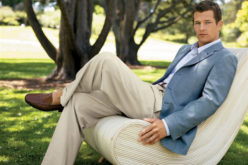Dressing well, without the tie
Q. I am really glad that going without a tie has become so popular, especially for business. Our office is still somewhat on the formal side; we wear suits, blazers, and sports coats – not polos and chinos – but ties are no longer essential. Even so, I notice that some guys still look sharper than others. I would like to be among that group. Do you have any suggestions on how to go about achieving that?
A. That is an interesting and different business environment with suits and no (or some) ties. I believe that the well-dressed man sets himself apart and shows himself as different (from other less clued-in) dressers. This is true whether he is dressed-up or casually put together. All manner of small points can add up to a big difference. As my regular readers know, I have trouble understanding why men who care about how they look are so quick to give up their ties when that one small item makes it so easy to display one’s taste and sense of style. But reality tells us that tieless business casual is fast becoming today’s way of life. And, since it is, let’s see what lessons can be learned about how to stand out from the crowd.
Some of the categories to concentrate on are coordination, color, fit, grooming, and a few specific tricks.
COORDINATION: While there are certainly more elements to combining a shirt, tie, and suit, the choice of the shirt in your tieless setting can make a tremendous difference. Some types of shirts look better without a tie than others. Shirts that are not overly dressy look better without a tie, while more formal shirts seem to need one.
Certain differences between dress/business shirts and sport shirts help you decide whether the shirt needs a tie.
*· Dress/business shirts are designed to be worn with or without a tie. A business shirt with dressy French cuffs and/or a wide-spread collar should be worn with a tie. If, on the other hand, a dress/business shirt has a preppy button-down collar or a straight point collar, and if it has barrel (button) cuffs, it will work either with or without a tie.
Sport shirts are designed to be worn without a tie. By definition, a short sleeved shirt is a sport shirt and should never be worn with a tie. Other elements that make a shirt a sport shirt and that disqualify it for wearing with a tie are: rough fabrics (such as flannel), bright colors, bold patterns (such as large plaids and Hawaiian aloha designs), and having two pockets.
COLOR: Coordination is also critical in terms of color. Learning to use color well is the least expensive and perhaps the most effective way to display a sense of style. A navy suit with a brown shirt may clash or at least seem off, whereas a khaki suit with a yellow shirt could be particularly handsome. When there are subtle shades or lines in the suit, repeating a color or choosing a close shade such as powder blue with a medium blue windowpane can display great sophistication.
Several years ago, when I was lecturing at a business conference held at a posh resort, the executive director said to me it was unfortunate that the dress code for those meetings was casual attire, because I would not be able to see which men knew how to dress and which ones needed help. I told him that the casual environment did not really make such a difference; I could still look at a group of men I did not know; and tell him which ones dressed well in any situation. I pointed to one man who was wearing khaki pants and a plaid sport shirt with a brown leather belt, and polished brown loafers: the plaid shirt was made of a few pastel colors as well as a shade of khaki that exactly matched his pants. I was certain that the man would be among the better dressers no matter how formally or informally he was dressed.
FIT: Is it worth $20 or more to help a $500 suit look like a $1000 one? That’s hardly a question. And there’s no question that the trick can be performed by the tailor/fitter who handles your suit’s alterations. He should know current style, your office setting, what you like and are comfortable in…but he also should have the ability/tact to point out if your preferences are out of the norm.
By the way, tipping the tailor is a wise investment. It is not considered demeaning. It is done all the time and in the very best stores. How much? Any tip, depending upon the extent of the alterations and how soon you need the garment, will make the tailor remember you and help show your appreciation for the superb work you are going to receive.
GROOMING: Going without a tie does not mean dirty shoes or any other type of sloppy dressing. Every aspect of careful grooming is important from a good haircut, to neatly-trimmed nails and well-polished shoes. One of the subtlest and yet most telling aspects of a man’s grooming is a perfectly-ironed shirt, whether it is worn with a tie or open-at-the-neck. This small element has more impact because it is so close to the face.
A couple of upgrade points:
All men, even those who have virtually eliminated ties from their wardrobes, can still take advantage of a colorful flourish provided by tucking a silk pocket square into their jacket’s breast pocket. It is not a necessary addition, but it can help with color coordination by repeating one of the colors in the rest of the combination.
The crispness and precision provided by a well-ironed (and perhaps starched) shirt can also be accomplished by using collar stays. They help keep an open collar evenly spaced and prevent it from falling limply askew. Brass stays seem to be even more effective than plastic ones.
Please send your men’s dress and grooming questions to MALE CALL: Lois.Fenton@prodigy.net








